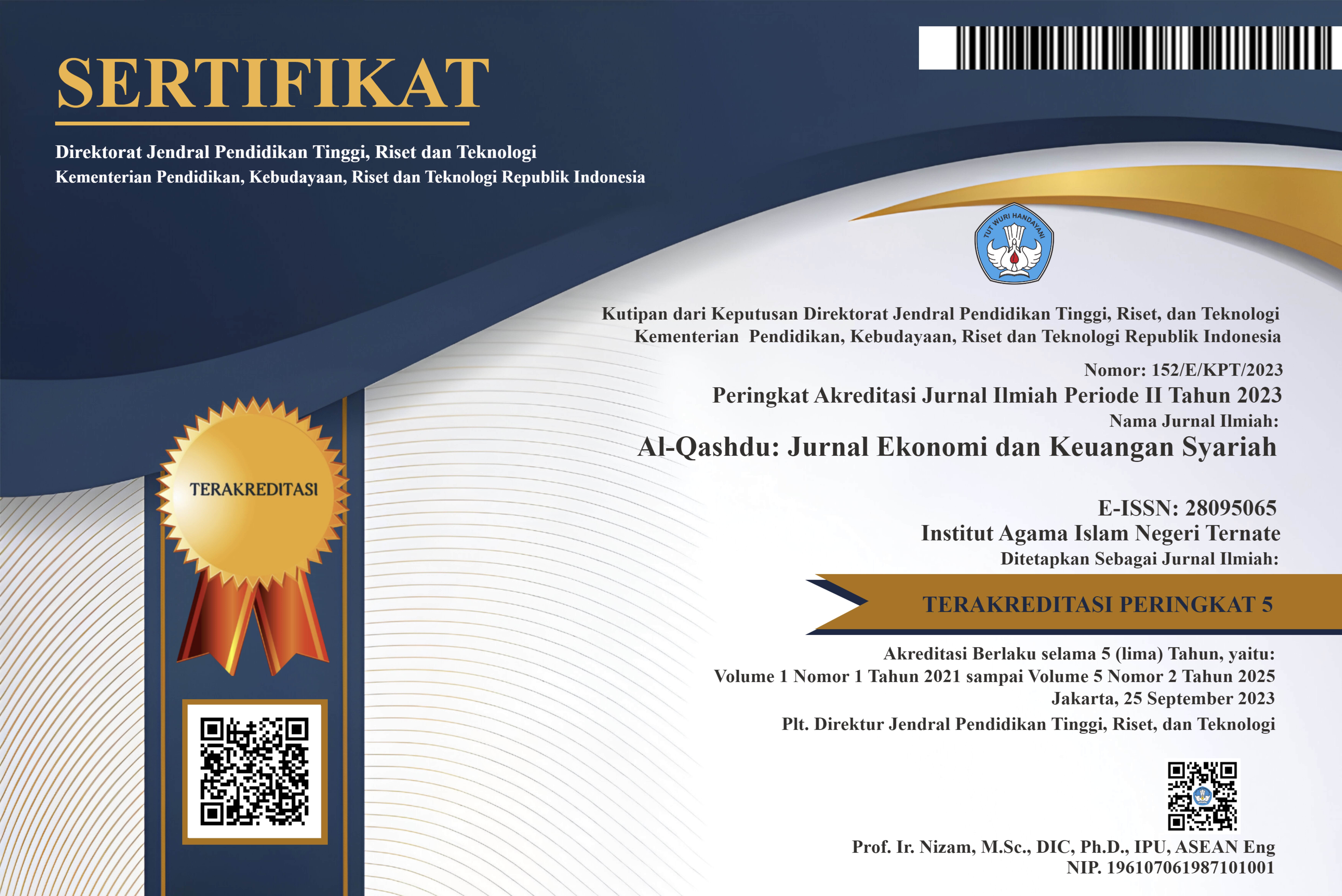ANALISIS KOMPARASI KINERJA KEUANGAN BANK UMUM SYARIAH DENGAN PENDEKATAN METODE CAMEL
Abstract
This study aims to compare the performance levels of two Islamic commercial banks in Indonesia, namely Bank BCA Syariah and Bank Muamalat Indonesia for the period 2018 to 2022. This study uses a method that is often used to analyze the level of performance of Islamic banking, namely the CAMEL method. The indicators in this study consist of five financial ratios, namely CAR, NPF, NPM, ROA, and FDR. This research uses quantitative methods with comparative research types. Using secondary data from financial reports published on the official website of each bank. Kolmogorov-Smirnov test is used for data normality testing and hypothesis testing using independent t-test and Mann-Whitney test. The results showed statistically significant differences in the values of CAR, NPF, ROA, and FDR in Islamic banking between Bank BCA Syariah and Bank Muamalat Indonesia, then there was no significant difference in the NPM ratio between the two banks. Based on the results described, Bank BCA Syariah has a superior average value in terms of CAR, NPF, NPM and ROA ratios compared to Bank Muamalat Indonesia. Meanwhile, the performance of Bank Muamalat Indonesia's FDR proportion is better than Bank BCA Syariah in recent years. Therefore, it can be said that Bank BCA Syariah and Bank Muamalat Indonesia have different performance.
Keywords: Financial Performance; Islamic Banks; Camels Method
Full Text:
PDFReferences
Akramunnas, A., & Kara, M. (2019). Pengukuran Kinerja Perbankan Dengan Metode CAMEL. Al-Mashrafiyah: Jurnal Ekonomi, Keuangan, Dan Perbankan Syariah, 3(1), 56–69. https://doi.org/10.24252/al-mashrafiyah.v3i1.7780.
Asraf, Yurasti, & Suwarni. (2019). Analisis Perbandingan Kinerja Keuangan Bank Syariah Mandiri Dengan Dengan Bank Mandiri Konvensional. MBIA, 18(3), 121–136.
Bisnis. com (2023). Pangsa Pasar Bank Syariah Stagnan, Daya Saing Jadi Ganjalan. Diakses 10 Oktober 2023, Pukul 20.15. https://finansial.bisnis.com/read/20230928/90/1699274/pangsa-pasar-bank-syariah-stagnan-daya-saing-jadi-ganjalan.
Fauzan, R., Wishanesta, I. K. D., Ruswaji, & Nasution, T. (2023). Manajemen Perbankan. Padang: Global Eksekutif Teknologi.
Firmansyah, H., Nawatmi, S., Zamora, R. A., HS, S., Mardani, D. A., & dkk. (2021). Teori Dan Praktik Manajemen Bank Syariah Indonesia. Cirebon: Penerbit Insania.
Ghasempour, S., & Salami, M. (2016). Ranking Iranian Private Banks Based on the CAMELS Model Using the AHP Hybrid Approach and TOPSIS. International Journal of Academic Research in Accounting, Finance and Management Sciences, 6(4), 52–62. https://doi.org/10.6007/IJARAFMS/v6-i4/2294.
Hutabarat, F. (2021). Analisis Kinerja Keuangan Perusahaan. Banten: Desanta Publisher.
Jumingan. (2006). Analisis Laporan Keuangan. Jakarta: Bumi Aksara.
Kariyoto. (2017). Analisa Laporan Keuangan. Malang: Universitas Brawijaya Press.
Kasmir. (2010). Analisis Laporan Keuangan. Jakarta: PT Rajawali. Pers.
Mili, M., Sahut, J. M., Trimeche, H., & Teulon, F. (2017). Determinants of the capital adequacy ratio of foreign banks’ subsidiaries: The role of interbank market and regulation. Research in International Business and Finance, 42, 442–453. https://doi.org/10.1016/j.ribaf.2016.02.002
Muhid, A. (2019). Analisis Statistik 5 Langkah Praktis Analisis Statistik dengan SPSS for Windows. Sidoarjo: Zifatama Jawara.
Muljaningsih, S., & Perdana, P. (2022). Bank dan Lembaga Keuangan lain di Indonesia. CV. Mitra Cendekia Media.
OJK. (2022). Laporan Perkembangan Keuangan Syariah Indonesia. Jakarta: Departemen Perbankan Syariah Otortas Jasa Keuangan.
OJK (2022). Statistik Perbankan Syariah (Sharia Banking Statistics) Desember 2022. Jakarta: Otoritas Jasa Keuangan Republik Indonesia Departemen Perizinan dan Informasi Perbankan.
Radjab, E., & Jam’an, A. (2017). Metode Penelitian Bisnis. Makassar: Lembaga Perpustakaan dan Penerbitan Universitas Muhammadiyah Makassar.
Roman, A., & Şargu, A. C. (2013). Analysing the Financial Soundness of the Commercial Banks in Romania: An Approach based on the Camels Framework. Procedia Economics and Finance, 6, 703–712. https://doi.org/10.1016/s2212-5671(13)00192-5.
Sarmigi, E., Putra, E., Bustami, Y., & Parasmala, E. (2022). Analisis Laporan Keuangan Perbankan Syariah. Indramayu: Penerbit Adab.
Siyoto, S., & Sodik, A. (2015). Dasar Metodologi Penelitian. Yogyakarta: Literasi Media Publishing.
Sugiono. (2013). Metode Penelitian Kuantitatif, Kualitatif dan R &. D. Bandung: Alfabeta.
DOI: http://dx.doi.org/10.46339/al-qashdu.v4i1.1282
Refbacks
- There are currently no refbacks.

This work is licensed under a Creative Commons Attribution-NonCommercial-ShareAlike 4.0 International License.

This work is licensed under a Creative Commons Attribution-NonCommercial-ShareAlike 4.0 International License.
Al-Qashdu: Jurnal Ekonomi dan Keuangan Syariah
Published by Faculty of Islamic Economics and Business, Institut Agama Islam Negeri (IAIN) Ternate
Jl. Lumba-lumba, Ternate City, North Maluku, Indonesia, 97727
Website: https://www.iain-ternate.ac.id/
Phone: +6281241674617
Email: alqashdu@iain-ternate.ac.id

